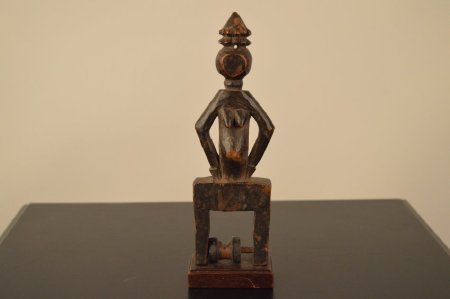Title:
Heddle Pulley
Object Name:
Pulley, Heddle
Other Name:
Heddle Pulley
Place of Origin:
Baoule, Ivory Coast, Africa
Provenance:
Aboriginal Indigenous Art.
H = 7—1/4"
W = 2—1/2"
D = 1—1/2"
H = 7—1/4"
W = 2—1/2"
D = 1—1/2"
Description:
Finial of three—quarter length figure, atop U—shaped pulley. Round cylinder floating between two legs, figure with cylindrical body, boneless bent arms, carved away from body, attached at waist. Small female breasts extended forward, double conical neck. Round head with flat face, double section conical headdress.
In traditional Africa, heddle pulleys were used in strip—weaving long narrow strips of cloth which would be later sewn together to make a large textile. Used in pairs, they allowed for the shifting of the warp threads so the weft thread shuttles could pass through. The finely carved pulleys of masks, heads and figures were intended to protect the weaver and help him produce fine cloth.
In traditional Africa, heddle pulleys were used in strip—weaving long narrow strips of cloth which would be later sewn together to make a large textile. Used in pairs, they allowed for the shifting of the warp threads so the weft thread shuttles could pass through. The finely carved pulleys of masks, heads and figures were intended to protect the weaver and help him produce fine cloth.
Collection:
Finley Collection
Material:
Wood
Used:
Ritually Used
Technique:
Carving
Owned:
Art Department, Missouri Southern State University
Accession#:
2014.1.19



